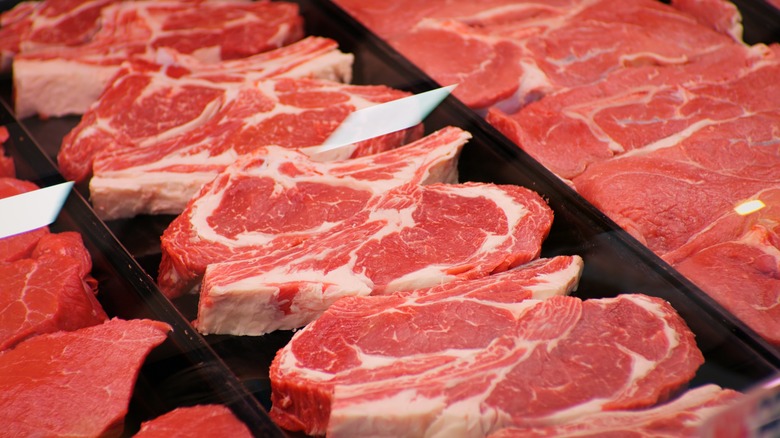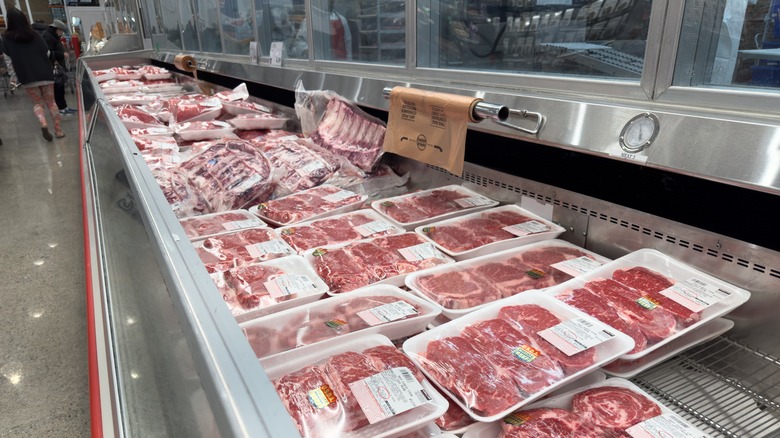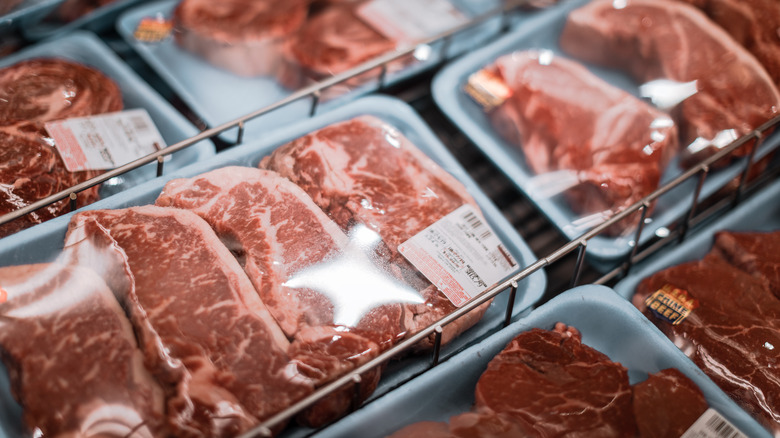The Tenderizing Process That Makes Costco Steaks A Bit More Risky
Costco is a great place to find a bargain, bulk sized goods, and a delicious hot dog with a soda (for under two dollars). The wholesale club has a cult following of dedicated shoppers who have a particular loyalty to Kirkland branded items. Many of Costco's products, from Kirkland brand vodka to its bakery's muffins, have garnered quite the fanbase of customers who praise the wholesaler's ability to produce and sell high quality products at a low price.
However, there are some Costco products that you might want to think twice about, including its steak. Though Costco's meat section is generally praised for its high quality, there may be some risk associated with its steak. This is because many of Costco's steaks undergo a process called mechanical tenderization. Mechanical tenderization is a process in which needles or small blades are used to pierce the flesh of steak in order to soften it.
Though this process helps to make steaks more tender, it also carries a risk of foodborne illness. The needles used to pierce the flesh don't just break up its tough connective tissue, but can also carry bacteria from the surface into the center of your steak. This is particularly dangerous for steaks that are cooked rare or medium rare, as the cooking on rare steaks usually only kills bacteria on the surface. If this bacteria is at the center, a rare cook won't be sufficient. So you might want to consider that before buying a pack of ribeye from Costco if you're planning on cooking it bloody.
The risks behind mechanically tenderized beef
It's worth it to dig a little deeper into how mechanical tenderization works. This process is relatively common practice in meat processing. As of 2018, 10.5% of beef products produced by meat manufacturers the United States were mechanically tenderized. That's no small chunk. However, though this practice is popular, it also comes with an inherent risk, as it can carry bacteria from the surface of meat into its center. This is particularly risky with steak, as many diners prefer their steaks to be cooked either rare or medium rare, which produces a final cook temperature between 125 degrees Fahrenheit and 140 degrees Fahrenheit. These temperatures are not high enough to kills potentially dangerous pathogens such as E.coli.
Mechanical tenderization has been tied to several food poisoning outbreaks across several countries, and does increase the risk of foodborne illness. In 2016, the United States government mandated that all beef processed with mechanical tenderization must be labeled to indicate the use of this processing. However, Costco, for its part, has been labeling its own beef since 2012, after its beef was linked to a Canadian E.Coli outbreak. The mandated labels include heating instructions for the beef, which indicate that the cuts should be cooked to at least 145 degrees Fahrenheit, and rested for three minutes after cooking. This will allow your beef to fully cook, and reduce risk of E.coli.
Making the most of your Costco cuts
So what should you keep in mind when shopping for beef at Costco? If you're looking to buy steaks from Costco, you should cook them in accordance with the label's guidance, especially if the label indicates that the beef has been mechanically tenderized. You will want to either cook your Costco steak well-done, to 160 degrees Fahrenheit, or cook it to 145 degrees Fahrenheit and let it rest for three minutes. Doing so will reduce the risk of foodborne illness when consuming these steaks. But if you want to cook your steaks to a lower temperature, you should probably avoid Costco's precut steaks, and pick up your meat from another grocery store. Just make sure to look out for labeling that indicates that your steak has been mechanically tenderized. If the pack isn't labeled, then you can rest assured that the steak has not undergone this process.
However, if you still want to purchase your beef from Costco while avoiding its processed beef, then it's probably best to stick with larger cuts of steak that have not been broken down. Of course, this means you will have to break down the steak into individual cuts on your own, and this is a process that requires some practice. So if this is not something you would like to undertake, and you still want to have your rare steak and eat it too (safely), then you might want to shop for your steak elsewhere.


